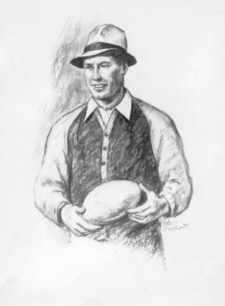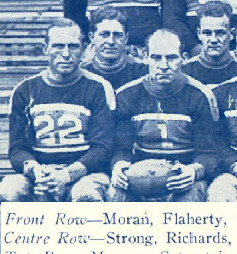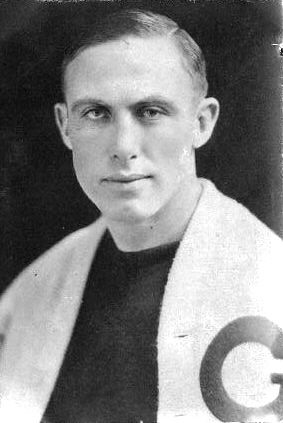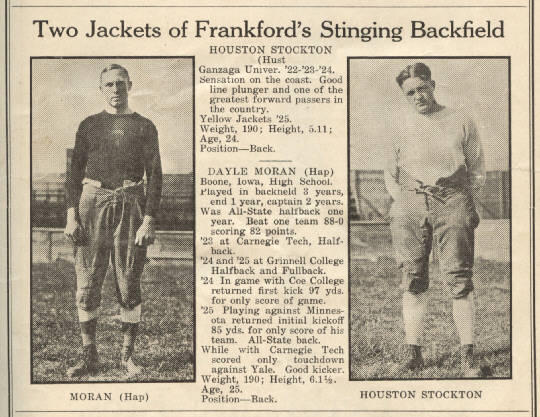 |
Hap Moran
1901 - 1994
by Michael Moran
Originally published in
The Coffin Corner
The Official Newsletter-Magazine
of the Professional Football Research Association
Vol. XXI, No. 6, 1999 |
| My father, Francis Dayle
“Hap” Moran, played eight years in the NFL – from 1926 through 1933.
Although he wasn’t a shy man by any means, he didn’t talk much about past
“glory days,” and it wasn’t until after his death in 1994 that a full
picture of his career became clear. All in all, I think you’ll agree, he was
the kind of player that made pro football the explosive, exciting sport that Americans
learned to love then and still love today.
In 1931 the New York Sportswriter and football enthusiast Paul Gallico wrote: |
| The best outdoor sports entertainment of the Fall
season was the football game between the New York professional football Giants and the
Green Bay Packers at the Polo Grounds last Sunday afternoon. Any time you can go to
a field and see Hank Bruder, Russ Saunders, Benny Friedman, Badgro, Moran and Blood
playing on the same afternoon, its something not to miss. |
|
| I was born 14 years after his last game,
so all I can go on is the memories of teammates and a scrap book of yellowing newspaper
clippings. Those clippings show that a few years in the NFL can certainly change a
player’s press. When my father broke into the league in 1926 with the Frankford
Yellow Jackets the sportswriters rave |
| A player by the name of Moran, the star of the entire
game, was unstoppable, through the line, around the ends, averting the opposing players,
and making the longest runs of the game. He seemed like he was right at home, and
was different from what went before… like a star let down from the planet Mars with
plays that the poor fish of the earth knew nothing about. We are certainly pleased
to tell our many readers of the wonderful addition this player has made to the team and
the spirit he put in the rest of the players. |
|

Not bad! “A star let down from the planet Mars
….” The Yellow Jackets went on to win the NFL title that year and Dad was
the second high scorer for the team and 12th for the NFL.
By 1933, Dad was with Tim Mara’s New York Giants (detail of team picture,
right). In his eighth and final season, he found himself described less
ecstatically:
|
| Mr. Mara has Hap Moran, who once upon a time played
with Carnegie Tech. Hap is thirty two years old and is now in his sixth season with
the Giants. Back in Boone, Iowa, in the winter he is a train dispatcher. Hap
has been around a long time and is pretty well battered, but they tie him together for a
few plays every Sunday and he usually catches a pass or two. |
|
| No doubt, my father helped the
Giants’ Harry Newman lead the NFL in passing that year. What with the
comparative rarity of forward passes in those days, anyone who could catch a “pass or
two” was doing okay. Harry Newman wrote to me after my father died: |
| Just for the record, Hap caught the first touchdown
pass I threw as a pro. It was not without reason that your Dad was called Hap.
He always had a smile on his face. |
|
Apparently, though, my father’s good
disposition didn’t keep him from being a target for battering by opponents.
How battered was he? There was a separated shoulder, broken fingers, and many broken
noses. In one game after he broke his nose he had a metal cup taped over his busted
beak for protection and went back in. A few moments later he got smashed in the face
a second time. The cup only added to the injury. On the way to the
hospital the car was pulled over by the police. There had been a bank robbery in the
neighborhood and the robber had been shot in the face. The way Dad looked, they
thought he was the perpetrator.
He was a tough man to get out of a game. Another time his mouth was badly
cut. He was stitched up on the sidelines and went back in to call plays. Bad
move. He suddenly realized his tongue had been sown to his lip! When he tried
to call a play he couldn’t talk.
All of the mayhem wasn’t caused by the other team. In a 1948 column, Arthur
Daley of the New York Times reported on a conversation between Steve Owen and Mel
Hein. |
| “Crowds never pour onto the field
these days the way they used to,” commented Mel. “Remember the time in
Stapleton when Hap Moran broke away down the sidelines? Just as he got into the
clear an indignant woman fan from Stapleton hit him over the head with her umbrella,
knocked him down and prevented the touchdown.” |
|
 So by 1933 Dad was
pretty well battered, but along the way he had contributed some great moments to the early
days of the NFL. So by 1933 Dad was
pretty well battered, but along the way he had contributed some great moments to the early
days of the NFL.
Although he eventually made his name in football, in High School he was better known for
basketball. He was captain of the Iowa All-State team and his team from Boone won
the state championship and the right to represent Iowa at the Interscholastic Tournament
at the University of Chicago. There he set a record for the longest shot in the
history of the tournament (they stopped the game and measured) and was named as a High
School All-American by Amos Alonzo Stagg. After one year at Grinnell College in Iowa
he was recruited by Carnegie Tech in Pittsburgh primarily for basketball. In those
days Carnegie Tech played Notre Dame, and in that game in 1922 the Four Horsemen first
formed up as a backfield under the coaching of Knute Rockne. Dad would later play
against that lineup in their last game together in 1930. When he got hurt playing
football, he lost his scholarship at Carnegie and went back to Grinnell.
In the days before the big pass dominated the game, it was the break away run that got the
crowd on its feet. It was also the long run that earned my Dad the reputation that
got him a shot at the pros. Two college games in which he ran opening kick-offs back
for touchdowns received wide coverage.
In 1924 the story read:
|
Grinnell Player Pulls a
‘Grange’ To Defeat Coe
“Hap” Moran, Grinnell fullback, threw
consternation into the ranks of the large crowd of Coe home comers today when he received
Smith’s kickoff on the 5 yard line and raced 95 yards through the entire Coe team for
a touchdown. Thereafter both teams battled firmly and the one touchdown constituted
the entire scoring, Grinnell winning, 6 to 0. |
|
| A similar 85 yard run back of the opening
kick off against Minnesota in 1925 also stood out as Grinnell’s only score, and both
these runs were highlighted in a letter of recommendation from his college coach to the
Frankford Yellow Jackets coach in 1926. His coach ended the letter: |
| One thing you’re going to like about Moran is
that he loves to play football. He will do anything you tell him and will work like
a Trojan, take discipline without any comment and will sacrifice himself at all times for
the benefit of the team. He is just as willing to block as run with the ball, as he
does not seem to care what his appointed duty is, just so he gets to play. If you
make arrangements to get this lad I feel you will be very satisfied. |
|
The
Frankford Yellow Jackets
NFL Champions 1926 |

|
Frankford gave him a contract, and in his first game as
a pro they got their money’s worth. It was a rainy September 25, 1926, a day,
the papers said, “more suitable for a swimming meet than a football game.”
The opponent was Akron, led by Fritz Pollard, the All-American from Brown, one of the few
black players in the NFL. Dad was so new to the team he didn’t even have a
number. He didn’t start, but he did get a chance to play, and he scored
Frankford’s only points of the day: |
Moran Sets Crowd Wild
The first quarter was thrill-less with the exception of a 26-yard
sprint by Moran around Akron’s right end. In the second period….a forward
pass, Smythe to Hap Moran, placed the pigskin on the 2 yard line, where, in the second
play, Moran took it over. |
|
| The next game he still had no number in
the roster. But he made the starting lineup at left halfback and stayed there for
the remainder of the season. Eventually they gave him the #4 jersey. |
| What must have been one of the more
exciting games of the season came on the weekend of October 16. The Yellow Jackets
were not allowed to play at home on Sundays. They were a Philadelphia team and
Philadelphia had “blue laws” which closed stores and sporting events on
Sunday. So they played their home games on Saturdays
and then often traveled to their opponent’s city for a return match on Sunday.
On the weekend of October 16 they played the New York Giants. The home game saw the
Jackets defeat the Giants 6 to 0 on two field goals by another rookie, Johnny Budd of
Lafayette College.
The next day the Yellow Jackets traveled with a thousand fans and
their Drum and Bugle Corps in chartered railroad cars up to the Polo Grounds for the
Giants first home game of the season. 15,000 fans attended, and again the Yellow
Jackets beat the Giants 6 to 0:
After vicious line
smashes by Moran, Stockton, and Hamer, the ball was carried deep into New York’s
territory where a pass - Stockton to Jones - resulted in a touchdown.

|
|
| Continue
reading about Hap Moran |


 So by 1933 Dad was
pretty well battered, but along the way he had contributed some great moments to the early
days of the NFL.
So by 1933 Dad was
pretty well battered, but along the way he had contributed some great moments to the early
days of the NFL.
